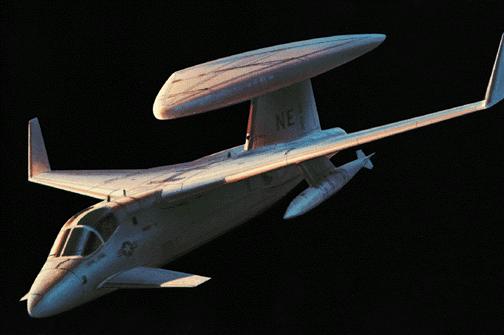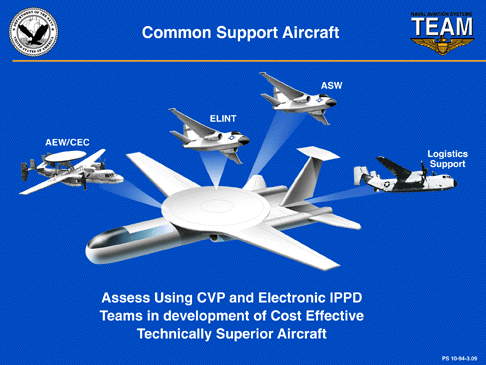
The Common Support Aircraft (CSA) will serve as the Navy's carrier-based surveillance, control, and support
aircraft for the 21st century, replacing existing S-3B, ES-3A, E-2C, and C-2A aircraft. Envisioned as a single aircraft
design, the CSA will be able to carry different mission suites of sensors and avionics in order to fulfill future mission
requirements and will possess significant capacity for logistics support and aerial refueling. CSA will facilitate naval
fires in the joint warfare battlespace with fuzed tactical data obtained from both on- and off-board sensors and with its
organic warfighting capability.
In 1993, a Naval Aviation study concluded that a "neckdown" of follow-on aircraft was the only affordable procurement strategy for future naval aircraft. Current investments in E-2C production, ongoing C-2 service life extension, and service life extension plans for the S-3 and ES-3 aircraft are needed to ensure that current airframes achieve the 2015 service life goal. Based on current fleet utilization rates and projected support aircraft inventories, the CSA will require a 2012 initial operational capability at the latest. Efforts are being explored to determine if an accelerated profile is feasible.
The study team has established CINC Coordination and Fleet User Teams to ensure the operational concerns of U.S. warfighters are highlighted, and to provide a forum that spans all warfare areas. Phase 1 defined future mission requirements by using top down, strategy-task-technology and quality function deployment methodologies that were rooted in joint military objectives. Phase 1 concluded in early 1997.
During Phase 2, the study will evaluate the technical and economic feasibility of a single airframe vehicle. First, the mission concept of operations in tactical situations will quantify performance values. Existing guidance will be used to examine the aircraft design possibilities for a multi-place aircraft sharing a common airframe, engines, and core avionics and having sufficient internal volume and carriage capability for mission-specific avionics, sensors, stores and weapons. The study group is also working with industry and examining advances in technology and the acquisition process to assess the feasibility of the CSA.
The CSA initiative is to commence a baseline development effort for the air vehicle prior to final weapon systems determination for the various mission variants. Based on the current and future "worst case" avionics suite, the baseline aircraft will be sized around the Hawkeye 2006 mission system which will provide growth potential for other mission area requirements and avionics upgrades. Significant work in formulating plans, options and contingencies are ongoing within the Fleet, acquisition community, and industry so that a streamlined effort can be initiated that minimizes program risk while exploiting commercial best practices and methodologies.
The Navy has deferred a formal acquisition plan for the Common Support Aircraft until the critical issues of resources, requirements and program timing are resolved. It may be more appropriate to call the program a Common Support Concept (CSC) which accommodates efforts to tailor CVW missions to the battlespace of the future. The support solutions of the future may not all entail a new aircraft. Current S-3 and C-2 airframe test articles will further define service life limits and SLEP alternatives. Support aircraft program initiatives such as the E-2 MYP, vertically cutting the ES-3A, and shedding S-3B mission areas have succeeded in pushing the requirement for a Common Support Aircraft further to the right than initially projected. Test article results will help to define our path and options in meeting support requirements. The vision for CSA is to use POM02 funds to start analysis of alternatives and roles and missions studies to solidify the requirements for a CSA platform. The conclusions of the analysis will be used to establish a roadmap and then move forward with the modernization of naval aviation's support aircraft inventories.
Lockheed Martin Aeronautical Systems examined four basic CSA concepts. These comprised the CSA-101, a low-risk solution similar in appearance to the S-3 and embodying a fin-mounted rotodome; the CSA-201, a more advanced design, with a triangular fin-mounted radome, and some low-observable features, such as faceting; the CSA-301, with full low-observability and conformal sensor arrays integrated into leading- and trailing-edges of a diamond planform; and a UAV design similar in appearance to Northrop's Tacit Blue stealth-technology demonstrator, but with a twin-boom tail.
Although the CSA project is still active, the requirements for the CSA have been delayed by the US Navy. Lockheed Martin has been pursuing a number of modernisation initiatives to extend service life of the S-3B Viking, which is a candidate for eventual replacement by CSA.


In 1993, a Naval Aviation study concluded that a "neckdown" of follow-on aircraft was the only affordable procurement strategy for future naval aircraft. Current investments in E-2C production, ongoing C-2 service life extension, and service life extension plans for the S-3 and ES-3 aircraft are needed to ensure that current airframes achieve the 2015 service life goal. Based on current fleet utilization rates and projected support aircraft inventories, the CSA will require a 2012 initial operational capability at the latest. Efforts are being explored to determine if an accelerated profile is feasible.
The study team has established CINC Coordination and Fleet User Teams to ensure the operational concerns of U.S. warfighters are highlighted, and to provide a forum that spans all warfare areas. Phase 1 defined future mission requirements by using top down, strategy-task-technology and quality function deployment methodologies that were rooted in joint military objectives. Phase 1 concluded in early 1997.
During Phase 2, the study will evaluate the technical and economic feasibility of a single airframe vehicle. First, the mission concept of operations in tactical situations will quantify performance values. Existing guidance will be used to examine the aircraft design possibilities for a multi-place aircraft sharing a common airframe, engines, and core avionics and having sufficient internal volume and carriage capability for mission-specific avionics, sensors, stores and weapons. The study group is also working with industry and examining advances in technology and the acquisition process to assess the feasibility of the CSA.
The CSA initiative is to commence a baseline development effort for the air vehicle prior to final weapon systems determination for the various mission variants. Based on the current and future "worst case" avionics suite, the baseline aircraft will be sized around the Hawkeye 2006 mission system which will provide growth potential for other mission area requirements and avionics upgrades. Significant work in formulating plans, options and contingencies are ongoing within the Fleet, acquisition community, and industry so that a streamlined effort can be initiated that minimizes program risk while exploiting commercial best practices and methodologies.
The Navy has deferred a formal acquisition plan for the Common Support Aircraft until the critical issues of resources, requirements and program timing are resolved. It may be more appropriate to call the program a Common Support Concept (CSC) which accommodates efforts to tailor CVW missions to the battlespace of the future. The support solutions of the future may not all entail a new aircraft. Current S-3 and C-2 airframe test articles will further define service life limits and SLEP alternatives. Support aircraft program initiatives such as the E-2 MYP, vertically cutting the ES-3A, and shedding S-3B mission areas have succeeded in pushing the requirement for a Common Support Aircraft further to the right than initially projected. Test article results will help to define our path and options in meeting support requirements. The vision for CSA is to use POM02 funds to start analysis of alternatives and roles and missions studies to solidify the requirements for a CSA platform. The conclusions of the analysis will be used to establish a roadmap and then move forward with the modernization of naval aviation's support aircraft inventories.
Lockheed Martin Aeronautical Systems examined four basic CSA concepts. These comprised the CSA-101, a low-risk solution similar in appearance to the S-3 and embodying a fin-mounted rotodome; the CSA-201, a more advanced design, with a triangular fin-mounted radome, and some low-observable features, such as faceting; the CSA-301, with full low-observability and conformal sensor arrays integrated into leading- and trailing-edges of a diamond planform; and a UAV design similar in appearance to Northrop's Tacit Blue stealth-technology demonstrator, but with a twin-boom tail.
Although the CSA project is still active, the requirements for the CSA have been delayed by the US Navy. Lockheed Martin has been pursuing a number of modernisation initiatives to extend service life of the S-3B Viking, which is a candidate for eventual replacement by CSA.
Specifications | |








No comments:
Post a Comment